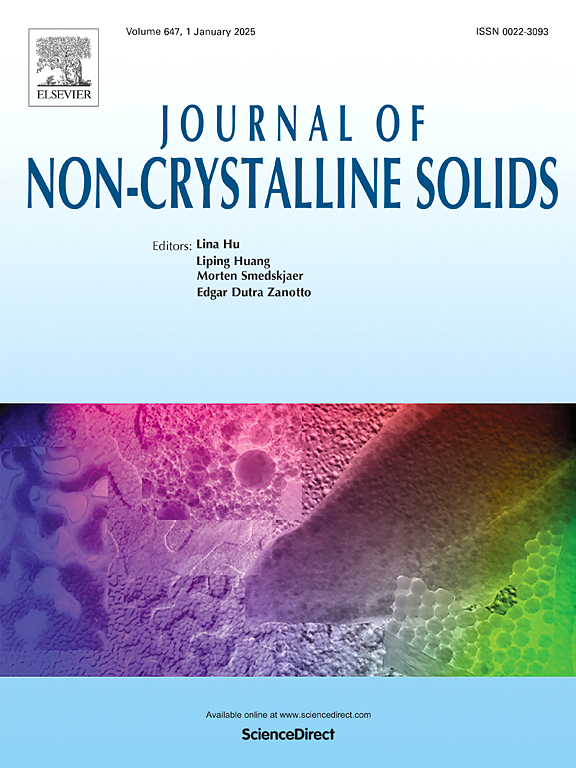Bi2O3 对 PbO⋅B2O3⋅Bi2O3⋅SiO2 玻璃结构和光学特性的影响
IF 3.2
3区 材料科学
Q1 MATERIALS SCIENCE, CERAMICS
引用次数: 0
摘要
本研究介绍了 Bi2O3 对摩尔组成为 17PbO⋅23B2O3⋅xBi2O3⋅(60-x)SiO2 的玻璃样品结构和光学特性的影响,这些玻璃样品是采用传统的熔体淬火方法制备的。X 射线衍射光谱显示了所制备系列的无定形性质。对密度(D)、摩尔体积(Vm)、玻璃化转变温度(Tg)和其他物理参数进行了评估。傅立叶变换红外光谱显示铋的结构单元为 [BiO3] 和 [BiO6],硼酸盐的结构单元为 [BO3] 和 [BO4]。研究发现,随着铋浓度的增加,非桥氧基的增加可归因于截止波长的增加和带隙能的降低。Urbach 的能量值表明,现有玻璃体系中 Bi2O3 的存在可能会影响缺陷浓度。所有玻璃样品都具有较高的折射率,这表明目前的玻璃可用于开发非线性光学系统。本文章由计算机程序翻译,如有差异,请以英文原文为准。
Influence of Bi2O3 on structural and optical characteristics of PbO⋅B2O3⋅Bi2O3⋅SiO2 glasses
In this study, the influence of Bi2O3 on the structural and optical characteristics of the glass samples with the molar composition of 17PbO⋅23B2O3⋅xBi2O3⋅(60-x)SiO2, prepared using the conventional melt quenching approach, is described. X-ray diffraction spectra reveal the amorphous nature of the prepared series. Density (D), molar volume (Vm), glass transition temperature (Tg), and other physical parameters have been evaluated. FTIR spectra show the presence of bismuth as [BiO3] and [BiO6] structural units and of borate as [BO3] and [BO4] structural units. It is found that the increase in non-bridging oxygens can be attributed to the increase in cut-off wavelength and decrease in bandgap energy with the rise in bismuth concentration. Urbach's energy values demonstrate that the presence of Bi2O3 in the existing glass system might affect the defect concentration. All glass samples possess a high refractive index suggesting that the current glasses may be useful for developing non-linear optical systems.
求助全文
通过发布文献求助,成功后即可免费获取论文全文。
去求助
来源期刊

Journal of Non-crystalline Solids
工程技术-材料科学:硅酸盐
CiteScore
6.50
自引率
11.40%
发文量
576
审稿时长
35 days
期刊介绍:
The Journal of Non-Crystalline Solids publishes review articles, research papers, and Letters to the Editor on amorphous and glassy materials, including inorganic, organic, polymeric, hybrid and metallic systems. Papers on partially glassy materials, such as glass-ceramics and glass-matrix composites, and papers involving the liquid state are also included in so far as the properties of the liquid are relevant for the formation of the solid.
In all cases the papers must demonstrate both novelty and importance to the field, by way of significant advances in understanding or application of non-crystalline solids; in the case of Letters, a compelling case must also be made for expedited handling.
 求助内容:
求助内容: 应助结果提醒方式:
应助结果提醒方式:


